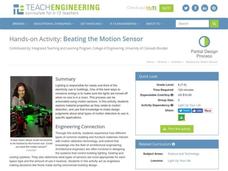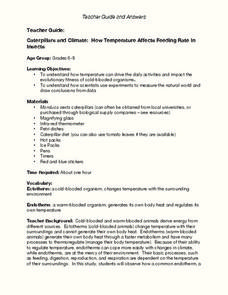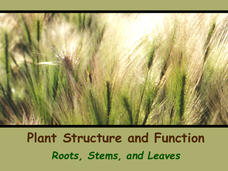Teach Engineering
Beating the Motion Sensor
I bet I can cross the room without having the lights come on. Class members set up an experiment in which they try to determine what materials will mask motion detected by a sensor. Groups predict how materials will interact with light,...
Science Matters
Wave Watching
Seismologists use the direction and arrival times of p waves and s waves to determine the distance to the source of an earthquake. The engaging lesson plan has students line up to form human waves. Through different movements when...
Science Geek
Nuclear Chemistry
Which bichemicals wash up on shore? Nucleotides! Presentation covers alpha, beta, and gamma radiation. Includes a comparison of fission versus fusion. Presentation is the second in a five-part series.
Bowels Physics
Direct and Inverse Relationships
Viewers learn to recognize direct and inverse relationships in the world of physics with a presentation that reveals how to recognize a direct versus an inverse relationship from a formula or graph. After showing basic examples, the...
Curated OER
Exploring the Water Cycle
The water cycle is one of earth's most easily observable processes, but demonstrating each step within classroom walls can be a challenge. Through a series of videos and quick demonstrations, cover each aspect of the hydrologic cycle in...
Polar Trec
Calorimetry Lab
Young people between the ages of 11–13 need on average about 2,000 calories per day. Within the lab, groups learn about calorimetry and respiration. They explore how it pertains to humans and animals living the Arctic where cold...
PBS
Breaking it Down
After challenging themselves to correctly choose the form of erosion and length of time required for a given landform to develop, earth science class members model mechanical and chemical weathering with various lab demonstrations over...
SFPOnline
States of Matter Worksheet
Young scientists get to the heart of the matter as they complete this learning exercise on the properties of solids, liquids, and gases.
ESL Kid Stuff
Can - for Ability
You can do it! Practice action verbs and using can for ability with a series of activities designed for English learners. Kids jump, stomp, and turn as they discuss the things they can and can't do.
It's About Time
The Chemical Behavior of Atoms
Assist your class with this colorful activity as students view and interpret changes in the hydrogen atom. They discuss concepts of the electromagnetic spectrum and use Bohr's model to predict wavelengths and light patterns,...
National Energy Education Development Project
Exploring Transportation
Did you know horsepower is actually based on the power of a horse? 60 horse power is the equivalent of being pulled by a team of 60 horses! Viewers will learn other interesting facts like this from a presentation that begins with the...
Garden Earth Naturalist Club
Parts of a Flower! Flower Dissection
Sometimes the best way to learn about plants is to see the different parts of a plant yourself. Groups of learners dissect flowers to answer questions about what they observe and what they wonder about their flower.
Port Jefferson School District
Hurricane Katrina
Young scientists track Hurricane Katrina across the Atlantic Ocean as they learn about these destructive forces of nature. Provided with a table of data tracking the location and conditions of Katrina over a one week span, students plot...
Curated OER
Connecting with Your Feelings
As part of a therapeutic and restorative exercise, pupils use worksheets to recall experiences and explore their reactions to major feelings, from anxiety and anger to joy and love.
Ask a Biologist
It’s a Plankton Eat Plankton World
For as small as they are, plankton sure play an enormous role in maintaining marine ecosystems. Dive into an investigation of these tiny organisms with a hands-on life science activity in which children cut out pictures of sea animals...
Scholastic
Spring Is Sprung: Water Movement in Plants
Young scientists use food coloring and celery stalks to determine how water travels through plants.
Curated OER
Caterpillars and Climate: How Temperature Affects Feeding Rate In Insects
Do you eat more when you are hot or when you are cold? Young scientists observe the eating pace of two caterpillars at different temperatures. The differences in endotherm and ecotherm animals' ability to adjust to temperature change...
International Technology Education Association
Pixel This!
Did the image I drew match the image you saw? By simulating a satellite and a ground station, teams of two transmit data in the form of pixels in order to recreate an image. They use four different levels of brightness, creating slightly...
K5 Learning
The Life Cycle
Studying plant, animal, or insect life cycles? Pair a science unit with a reading comprehension learning exercise on life cycles. The passage touches briefly on butterfly, plant, frog, and dog life cycles before prompting readers to...
Biology Junction
Plant Structure and Function: Roots, Stems, and Leaves
Scientists found fossils of plants more than 420 million years old—but plants existed for up to 100 million years prior to these fossils. Learn about the importance of plants to the entire planet. Viewing a presentation helps scholars...
Curated OER
Light the Bulb
Students explore electricity. In this power experiment lesson plan, students determine what is required for lighting a bulb. Students develop an understanding of open and closed circuits, and how energy is formed
Curated OER
Making Waves with the Electromagnetic Spectrum
Young scholars examine different types of electromagnetic waves and their sources. In this electromagnetic waves instructional activity students view a video and complete a handout.
Curated OER
Oh Nuts! - Calories Count
Students measure and record the mass of the nut to be tested to the nearest 0.01 gram.
Curated OER
Let There Be Light
Students observe that different lights have different effects on matter. Students see that ultraviolet light is powerful although it cannot be seen through this teacher led demo-experiment.
Other popular searches
- Types of Energy Sources
- Types of Energy Transfer
- Different Types of Energy
- Energy Types
- Definitions Types of Energy
- 7 Types of Energy
- 6 Types of Energy
- Types of Energy Website
- 7 Energy Types
- Types of Energy Cycles
- Energy Types Of

























